5-out youth drive and kick
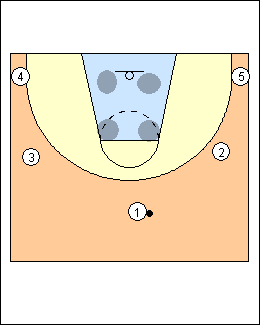 | 1 Motion offence teaches good basketball skills and principles (see Offence - 5-out youth motion), but many young players don't yet have the skill set to executive an attack based on passing and cutting, especially against defenders that get in the passing lanes to deny direct passes. Since the idea is to attack the basket, and the easiest way for younger players is by dribbling, they should work on dribble penetration. Space the floor so the ball handler always has an open lane to the basket, then move on penetration to create passing angles and make it hard for off-ball defenders to help and recover. If a driver gets stopped, pass to a teammate then it's his turn. This is the basis of the "dribble-drive attack" developed by Vance Walberg and popularized by John Calipari, and movement off penetration is the first concept in Rick Torbett's "read and react" offence.Goals on dribble penetration: - fill behind the dribbler (his bail-out spot, he can jump stop, reverse pivot on the foot closest to his defender, and pass back) - give the dribbler at least one passing option on the same side as the ball (a natural pitch, not passing across his body) - create a passing lane with no teammate or defender between you and the ball (no three-in-a-row, can the ball see you), e.g. if you slide with the drive, your defender can play both - have a safety out top. Especially with young players, having teammates cut into the lane on dribble penetration makes for shorter passes to players in shooting range and in good rebounding position. Basketball Australia - the offensive team must provide passing options when the defence rotates to help the defender who has been beaten. There are four "receiver spots" in the key (shown), on penetration into the key both baseline receiver spots should be occupied, and one of the top receiver spots. A player's exact spot will be determined by where the defenders are, move to a spot where the ballhandler could pass it to them. Players in receiver spots are in good rebounding position. Patrick Hunt - there are four receiver spots in the key (edges of the backboard and inside the elbows), every time the ball is driven into the key two of the four spots must be filled. That's a Foul (May 2003) - fill two of the "receiver spots" or "hot spots", always have a 3-point threat opposite the ball, and a player covering the point (safety). Rick Torbett - the other players circle in the direction of the dribble, and there is always someone in the "hole", the place the penetrator just left (his bail-out). Pass ballside on one dribble, pass back on two dribbles. If you are in the lane when the ball is being driven to the basket, go to a short corner if the ball enters the lane above you, or to an elbow if the ball is below you. See Tactics - 4-out 1-in drive and kick. |
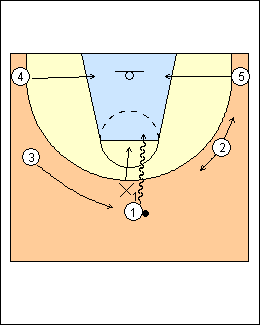 | 2 On a right-hand drive from the top, - 4 and 5 cut to the baseline hot spots - 3 fills behind the drive as bail-out and safety - 2 slides towards the corner, or curls behind the drive if his defender helps across. 1 can pass to 2 or 5 or back to 3 without passing across his body. That's a Foul - 4 and 5 cut to the baseline hot spots, 3 goes opposite the ball for a 3-point shot, 2 covers the point. Hunt - 4 and 5 get to bottom receiver spots, 2 slides, 3 fills behind the drive. Rick Torbett - circle movement, 5 cuts through, there is no space to circle. Often the dribbler can't beat his check, perimeter defender X2 stays with the sliding action, so 2 looks to reverse direction, especially when the passer is in trouble. The other players react to this movement. Millar - natural pitch to 2 sliding to the corner, dish pass to 5 under the basket, 3 is the safety valve behind the dribbler, 4 lifts from the corner (and is replaced by 5). John Calipari - if 2 slides his defender can play both. Variation - 4 and 5 get their heels to the baseline in an open gap (Lawrence Frank). |
 | 3 If dribbler 1 gets stuck and kicks the ball to the perimeter, he gets back out along with teammates who filled hot spots, now it's 3's turn. Mike MacKay - exit cuts - a general rule of thumb is that if there is one player on the side of the pass, exit out the same side; if there are two players on the side of the pass, exit back to the side you came from. |
 | 4 On a left-hand drive from the top, - 4 and 5 cut to the baseline hot spots - 2 fills behind - 3 slides or curls behind the drive. |
 | 5 On a middle drive from the wing, - 4 and 5 get to baseline hot spots - 1 and 3 fill behind the drive (1 is bail-out, 3 is safety) That's a Foul - 4 and 5 cut to the baseline hot spots, 3 spots up, 1 covers the point as safety. Hunt - 4 and 5 fill the bottom receiver spots, 1 and 3 work on being a safety and in space (he shows 1 filling behind and 3 widening the drive). Torbett - circle movement, 1 and 3 move in the direction of the dribble, 4 cuts through on the baseline, 5 lifts out of the corner. |
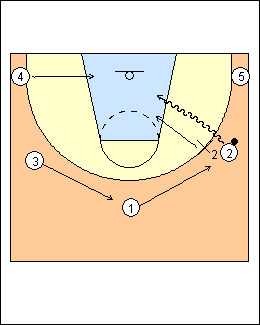 | 6 On a baseline drive from the wing, - 4 cuts to the weakside bottom hot spot - 5 spots up in the corner (he doesn't have room to cut along the baseline) - 1 and 3 fill behind. 2 can pass to 5, 4, and 1 behind without passing across his body. |
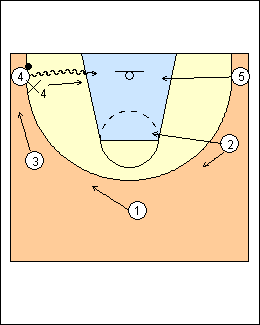 | 7 On a baseline drive from the corner, - 5 cuts to the weakside bottom hot spot - 3 fills behind (bail-out) - 1 fills behind and is safety - 2 gets inside the weakside elbow (high hot spot). 4 can pass baseline to 5 or behind to 3 (or across his body to 2 or 1). Note that at higher age levels, 5 and/or 2 could stay behind the arc if they are 3-point shooters. That's a Foul - 5 cuts to the baseline hot spot, 1 gets to a high hot spot (weakside elbow), 2 can flare (widen), 3 covers the point. Hunt - 3 gets inside the ballside elbow, 1 fills behind 3, 5 cuts to the weakside edge of the backboard, 2 drifts to the weakside corner. Torbett - for passing angles on baseline penetration fill four positions, drift (opposite corner), 45 degrees (opposite elbow), 90 degrees (ballside elbow), and safety behind the ball (circle movement except in the weakside corner). How far away they are from the basket depends on the positions of the defence. Millar - circle movement except the closest player fills the opposite corner (baseline drift), the natural pitch is straight ahead. 3 is the safety valve behind 4, 1 is at 90 degrees (ballside elbow), 2 at 45 degrees (weakside elbow). |
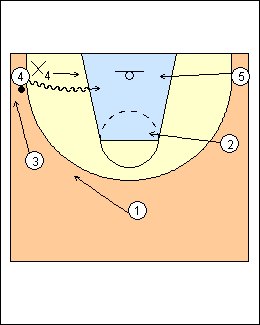 | 8 Spacing is the same on a middle drive from the corner, 4 has more options without passing across his body. Millar - the other players circle one spot to the right, 5 cuts along the baseline replacing 4 in the left corner (the left wing is open for 4). |
This page was made with Basketball playbook from Jes-Soft